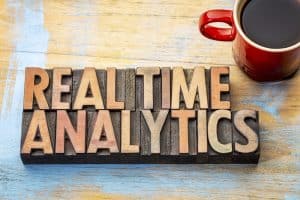
Given the evolving global landscape, the State Department needs data-driven insights just as enterprises get with real-time analytics.
When discussing use cases for real-time streaming and analytics, we’re usually penned in by business thinking. How can real-time data improve the customer experience, streamline processes, or help leaders make better decisions? While speaking at the 2022 Cloudera Government Forum, the CIO of the State Department’s Bureau of Intelligence and Research reminded us of another compelling use case: diplomacy.
At the event, Dominic Cussatt said, “Just imagine the possibilities of real-time data feeds to our State Department and foreign service workforce. It could really make a difference. … Having data streaming and these new and exciting cloud platforms that are now available to us helps us get data to places quickly that it’s never been able to get to before. It could be a game-changer.”
Cussatt said that while data is incredibly valuable to American diplomatic work worldwide, having outdated information can sometimes be worse than having none at all. He’s trying to avoid hearing “I wish I’d had that a week ago” from State Department officials, as that means they might have made a flawed decision, despite trying to be data-driven.
See also: Implementing Blockchain to Revolutionize Government Work
The unique data challenges of diplomats
Much like a manufacturing plant floor, a smart city, or an IIoT network on an offshore wind farm, diplomats work in hostile environments. These hostilities might be a little different than most technology leaders in business are used to, but they’re just as difficult to navigate — even with data.
The dynamics between countries change all the time, with thousands of different facets. A change in trade policy between countries A and B can enormously impact border security between countries Y and Z. All of these relationships need to be managed and negotiated in real-time, which presents an enormous challenge for diplomats. If they’re not aware of these changes, they lose bargaining power or make mistakes that can, in worst-case scenarios, cost American civilians their lives.
The State Department likely has many times more data sources than most businesses, making ingesting, normalizing, centralizing, and analyzing all this information extraordinarily complex. They need talented data scientists and knowledge workers to consistently delve into this sea of information and find truths that are genuinely meaningful to diplomats.
And no matter how physically hostile the area is or isn’t, the State Department also has numerous people working in remote areas with less-than-ideal networking for real-time data streaming and analytics. Maybe the latency is too high to send data to a centralized service in the State Department’s infrastructure and expect returned insights in a valuable timeframe for their ongoing missions. Maybe they don’t have enough computer power on-site to collect data locally and run meaningful analysis.
The State Department’s real-time analytics future
Last September, the State Department revealed its first-ever Enterprise Data Strategy, a three-year plan for strengthening policy and implementation around “data-informed diplomacy.”
“When our foreign affairs professionals are equipped with high-quality and timely data, we can make the world safer, more just, and less divided,” writes Brian P. Mckeon in the report. “We must continue to invest in recruiting, training, and equipping our teams to be skilled data consumers and users. This will take time, but we have none to waste.
The report says that given the evolving global landscape, their need for data-driven insights, and the general increase in the pace of technological innovation, the State Department needs to start thinking about data the way an enterprise would. They can’t sit on their laurels, thinking of data as a “nice-to-have” benefit. Accelerating changes to global stability mean data must be a dependable strategic asset.
The State Department’s Enterprise Data Strategy has a few core missions:
- Cultivate a data culture: The State Department is working to close its existing skills gap for technologists who can create and maintain streaming systems and the analysts who attempt to make sense of the data. They want to hire for the future and make sure people collaborate on data-driven decision-making no matter their title or where they’re working from.
- Accelerate decisions through analytics: The core goal is to deliver more modern analytic products and tools to diplomats around the world to improve access, including more customer service to enable more people. The State Department is also looking to pilot new AI/ML-based workflows they haven’t experimented with yet.
- Establish mission-driven data management: The State Department seeks to define a data architecture and global data standards to ensure that more diplomatic workers can collect and share data with other agencies or directly to the American public. This includes an ongoing data quality program to build and maintain trust in the data.
- Enhance enterprise data governance: With a global workforce, the State Department needs a single data governance model, including policies, process controls, and investment decisions. This also includes consistently measuring the value of data and analytics to the State Department — a difficult task considering the “soft” value of diplomacy and discovering proper attribution for wins.
The State Department’s plan also stipulates that all real-time data streaming and analytics should be shared, applied, governed, ethical, and secure. That’s their strategy for ensuring data is used effectively and with accountability to the American taxpaying public.
Cussatt’s statements are the latest we’ve heard about specific government plans around real-time analytics, but they’re a good indication that since the announcement of the Enterprise Data Strategy itself, they’re well on their way toward making specific investments for their data-driven future.





























